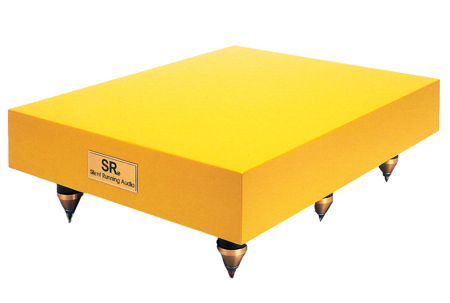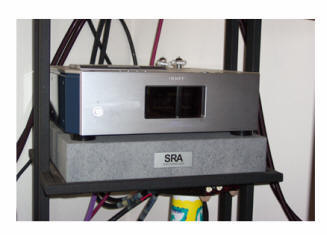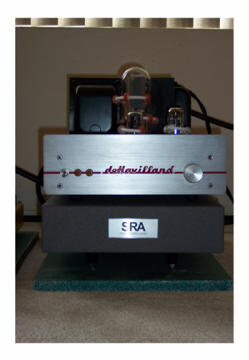You are reading the older HTML site
Positive Feedback ISSUE
16
november/december 2004
silent running audio
VR Isolation Bases
as reviewed by Roger S. Gordon

|
ROGER S. GORDON'S SYSTEM
LOUDSPEAKERS
ELECTRONICS
SOURCES
CABLES
ACCESSORIES
|
Any audiophile knows that there are good vibrations and bad vibrations. We also know that if we eliminate 0bad vibrations from our audio system, it will sound much better. Many of us have spent a lot of time and money experimenting with pucks, balls, bearings, cones, brass, wood, sand, graphite, etc. You name it, and we have probably tried it. If your experience has been like mine, virtually every isolation device has changed the sound of your system, but in many cases the change was just that—a change, not an improvement. When the change was an improvement, it usually was not earth shattering. Fortunately, most of the vibration control devices that I have tried have been both beneficial and low in cost. Herbie's Tube Dampers (see PFO No. 7) and the Bright Star Audio Big Rock Sand Box (PFO No.4) are examples of simple, bang-for-the-buck tweaks. Obviously there are more costly vibration control devices (Vibraplanes, Black Diamond Racing Shelves, etc.) but experimenting with these is impossible for audiophiles on a budget, so I had never tried any.
Thrifty Scot that I am, I peruse the web
looking for audio bargains. By buying used equipment, I really stretch my
audio budget. While doing one of my routine web scans, I noticed that one of
my local high end stores was selling a used Silent
 Running Audio VR
Isolation Base for a Sony SCD-1 SACD/CD player. I own a Modwright-modded
SCD-1 (see PFO No. 14), but knew nothing about Silent Running. Their
website turned up some interesting information. Each base is built to order
for the component that will be placed on it, so the bases are not
interchangeable. The technology is derived from devices used to eliminate
vibration from the sonar gear of nuclear submarines, ergo the company name
and that of their top-of-the-line isolation base, the "Ohio Class."
Intrigued, I stopped by the dealer and asked to see the base they had
advertised. It was a fairly nondescript, grey, rectangular box on four short
legs. The dealer claimed that it was very effective. Could I buy it with a
three-day, no-questions-asked, money-back guarantee? After a few moments,
the dealer said, "Sure. You won't be bringing it back," so into the storage
room we went to locate the wooden crate that each Silent Running Isolation
Base is shipped in. Crate located. Base put into crate. Crate put into trunk
of car. Return to domicile.
Running Audio VR
Isolation Base for a Sony SCD-1 SACD/CD player. I own a Modwright-modded
SCD-1 (see PFO No. 14), but knew nothing about Silent Running. Their
website turned up some interesting information. Each base is built to order
for the component that will be placed on it, so the bases are not
interchangeable. The technology is derived from devices used to eliminate
vibration from the sonar gear of nuclear submarines, ergo the company name
and that of their top-of-the-line isolation base, the "Ohio Class."
Intrigued, I stopped by the dealer and asked to see the base they had
advertised. It was a fairly nondescript, grey, rectangular box on four short
legs. The dealer claimed that it was very effective. Could I buy it with a
three-day, no-questions-asked, money-back guarantee? After a few moments,
the dealer said, "Sure. You won't be bringing it back," so into the storage
room we went to locate the wooden crate that each Silent Running Isolation
Base is shipped in. Crate located. Base put into crate. Crate put into trunk
of car. Return to domicile.
After dinner that night, I fired up the system and played several CDs that I use to audition equipment, including the soundtrack to Black Hawk Down (Decca 440 017 012-2), Lisa Garrard, The Mirror Pool (4AD 9 45916-2), and Samuel Barber, Violin Concerto, Hilary Hahn (Sony SK89029). With the system warmed up and my ears re-familiarized with my CDs, I disconnected the SCD-1 and lifted it off the equipment shelf. I hate moving 70-pound pieces of equipment! Onto the shelf went the VR base, then the SCD-1 on top of the base. The Isolation Base has the same footprint as the SCD-1, so the player must be carefully positioned. I reconnected the SCD-1, put the Black Hawk Down CD back into the player, settled into my lounge chair, and hit "Play" on the remote. With the first notes, I knew that the VR Isolation Base would not be going back to the dealer. I played all of my audition CDs, one after the other. What I heard was consistent from disc to disc. The greatest change was in the lowest octave, with the improvement slowly diminishing with each higher octave. By the upper midrange I could not hear any improvement.
The greatest change was in the low bass, which became tighter and more tuneful. The bass guitar solo on the title track of Bela Fleck's Flight of the Cosmic Hippo (Warner Bros 9 26562-2) was a treat. Without the VR Isolation Base, the notes were slightly smeared. With the base, each note was clearer and more distinct. On all of the CDs that I played, I heard details that I had never heard before. On each CD, the soundstage was slightly wider and much deeper. When I shut the system down for the night, I was a very tired but very happy camper. This was the biggest single tweak I had ever made in my system. The change was not subtle. It was like going from zip cord to a $2000 set of speaker cables—a night and day improvement.
As the weeks passed, I played more and more CDs on my improved system and continued to marvel at the wonderful bass that I was hearing. Also, on every CD I played I heard details I had never heard before. Then I thought, "Hmmmm. If the VR Isolation Base works under a component with moving parts, like a CD player, could it work a similar miracle under my deHavilland 845-G single-ended triode monoblock amplifiers (see PFO No. 12)?" While amplifiers don't have moving parts, transformers vibrate, and the deHavilland has three humongous transformers per channel. Vacuum tubes are also susceptible to airborne vibrations (see PFO No. 7 for my review of Herbie's Audio Lab Tube Dampers). I went back to the Silent Running website. How much would a pair of VR Isolation Bases for my amps cost? The only way to find out is to submit the lengthy questionnaire/order form that asks you to describe your equipment and the room your equipment is in. Submitting the form is a no-obligation request for a quote, so I filled it out and submitted it. I received an email the next day asking me to clarify a few details. I responded, and the following day I received my quote—$585 per isolation base, including free shipping via FedEx Ground. Ouch. I mulled the decision over for a few days. The chances of finding deHavilland amp bases on the used market were probably slightly greater than winning the Lotto. Did I want them enough to pay full retail? Yes, so off went my order.
It takes a while to build each Silent Running base. Each is a sealed box built from proprietary material. The box is essentially a raft floating on a base supported by feet. Inside the box are semi-solid materials that almost instantaneously convert vibration into heat. The thickness of the material used to build the box is determined by the weight of the supported equipment and how that weight is distributed. The type and amount of semi-solid material put into the box is determined by the anticipated vibration, both from the supported equipment and from your other equipment. The type of feet used with the base are also determined by your application. Bases going onto a shelf get short feet. Bases going onto a carpet get longer ones, to raise the platform above the carpet.
 During my waiting time, I exchanged a few
emails with Kevin Tellecamp, owner and chief designer of Silent Running. He
told me that putting their isolation bases under amps yields greater sonic
benefits than putting them under CD players. I was also warned that the
lengthy, bumpy ride in the FedEx truck shakes up the semi-solids, so while
the units will sound okay right out of their crates, it takes two days for
them to sound their best. Wanting to hear the full impact of the Isolation
Bases, I took Kevin's advice and waited two days before slipping them under
my amps. Before doing so, I played a number of my audition CDs. After
placing the VR Isolation Bases under the amps, I replayed the Black Hawk
Down CD. Once again, I recognized the changes from the first notes, and
the changes were the same ones that I had heard when I used the base under
the SCD-1. The new bases simply carried the improvements further. For
example, the sound of the bass guitar on "Flight of the Cosmic Hippo" got
even better. Not only was each note clearer and more distinct, but I could
hear Victor Wooten's fingers sliding up and down the strings. I heard more
detail, a bigger soundstage, and better bass, and this time the improvements
could be heard on both my sources, not just SACD/CD.
During my waiting time, I exchanged a few
emails with Kevin Tellecamp, owner and chief designer of Silent Running. He
told me that putting their isolation bases under amps yields greater sonic
benefits than putting them under CD players. I was also warned that the
lengthy, bumpy ride in the FedEx truck shakes up the semi-solids, so while
the units will sound okay right out of their crates, it takes two days for
them to sound their best. Wanting to hear the full impact of the Isolation
Bases, I took Kevin's advice and waited two days before slipping them under
my amps. Before doing so, I played a number of my audition CDs. After
placing the VR Isolation Bases under the amps, I replayed the Black Hawk
Down CD. Once again, I recognized the changes from the first notes, and
the changes were the same ones that I had heard when I used the base under
the SCD-1. The new bases simply carried the improvements further. For
example, the sound of the bass guitar on "Flight of the Cosmic Hippo" got
even better. Not only was each note clearer and more distinct, but I could
hear Victor Wooten's fingers sliding up and down the strings. I heard more
detail, a bigger soundstage, and better bass, and this time the improvements
could be heard on both my sources, not just SACD/CD.
Two days after I inserted the VR Isolation Bases under the amps, I had an audiophile friend come over. I wanted to do A-B comparisons with the bases, and slipping them in and out from under the amps is much easier with two people. Also, two sets of ears are always better than one. When my friend arrived, the bases were under the amps and I played CDs. We listened to a few tracks, then stopped and took the bases from under the amps. We played the same tracks again. The sound was not quite as detailed, but the change was not large. I suggested that we switch to vinyl, which in my system has greater resolution. I played the first couple of minutes of the Wilson Audio recording of Hyperion Knight's performance of Beethoven's Piano Sonata in C, Op.53, "Waldstein" (W-8313). We then put the bases back under the amps. When I put the needle to the vinyl, the sound of the opening chord was immediately followed by an expletive from my friend. When he got his jaw up off the floor he said, "This is unbelievable. I'm not going to come over here anymore. Its getting too #$@%$# expensive." What was my friend hearing? To paraphrase him, "The piano sounded more like a piano. The sound was richer and fuller. It had more presence in the room. Without the bases, it sounded like a very good recording of a piano. With the bases, it sounded like a piano." We then decided that there was no longer any need to continue with the A-B comparisons, and sat back to enjoy the music.
I have now had the VR Isolation Bases under my amps for over a month. I am still amazed at the increased detail and musicality that I hear from familiar recordings. The VR Isolation Bases have kicked the performance of my system up a full notch. I have just started an audition of power cords. With the increased resolution that the VR Isolation Bases give, hearing the differences between AC cords is now extremely easy.
Are there any drawbacks to the VR Isolation Bases? Other than cost, I can't think of any. Some vibration control devices remove vibration from the system but seem to suck the life out of the music. Not so with the VR Isolation Bases. The music simply gets more detailed, more realistic, and more musical, without any negatives. Obviously, the higher the resolution of your system, the more benefit you will receive from using them. They cost $300 to $800 per base, so if you want to kick your system up a notch and can afford them, get online with Silent Running Audio. Highly recommended. Roger S. Gordon
Silent Running
web address:
www.silentrunningaudio.com
